Moroccan Chicken Tagine
This post may contain affiliate links. See my disclosure policy.
This Moroccan chicken tagine recipe features tender chicken, butternut squash, dried apricots, raisins, almonds, and a whole host of Moroccan flavors that come together to create a highly fragrant and unforgettably delicious dish! This chicken tagine is naturally gluten-free and dairy-free and I’ve included instructions for making a vegan chicken tagine.
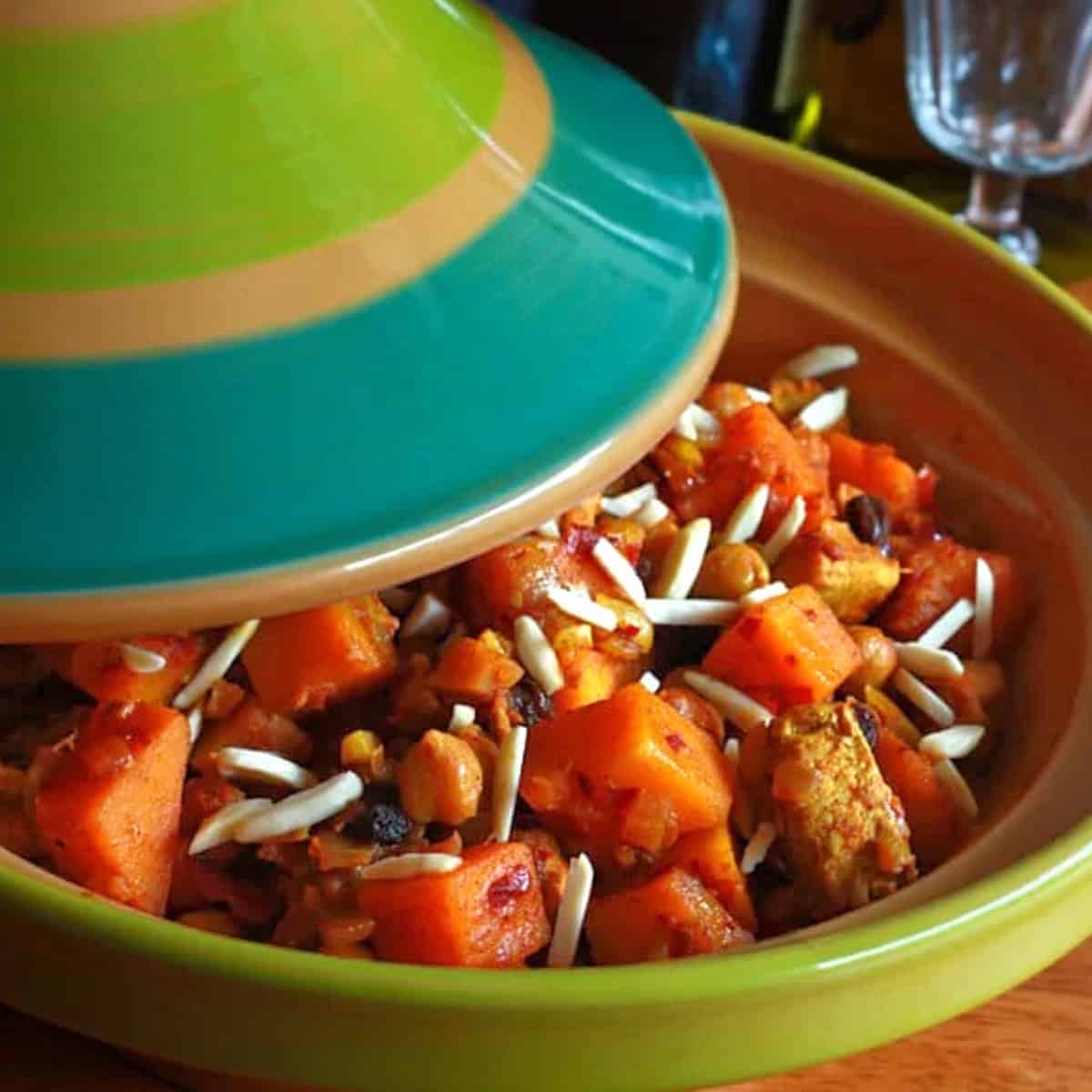
Moroccan cuisine is considered to be one of the most diversified cuisines in the world. This is because for centuries Morocco has been very interactive with other nations and has embraced and integrated many different cultural influences, not only in its foods but its art, music and literature. One of Morocco’s top priorities has been to protect and preserve its diverse legacy and culture. Moroccan cuisine is primarily Berber-Moorish, but is also influenced by Europe and the Mediterranean in some of its techniques and flavors. Spices are used extensively in Moroccan cooking. Meats, vegetables and dried fruits are a common food combination, as represented in today’s dish. While beef and lamb are eaten, chicken is the most widely eaten meat in Morocco. The national dish is couscous topped with meat and vegetables.
This chicken tagine recipe utilizes traditional Moroccan ingredients and spices. Chicken, squash, dried apricots, raisins, almonds, honey, a variety of spices, and harissa – a fiery Moroccan chili paste. Delicious as a vegetarian option as well (see recipe). Make this Moroccan Tagine for your family or dinner guests, and they are sure to be impressed. And if you really want a conversation piece, purchase and serve it in a tagine (where the name of the dish comes from). See note below. Enjoy some Moroccan music in the background and have a discussion about culture, art, life! Or imagine bringing this to a potluck…can you just hear the “ooh’s” and “ahhh’s”!
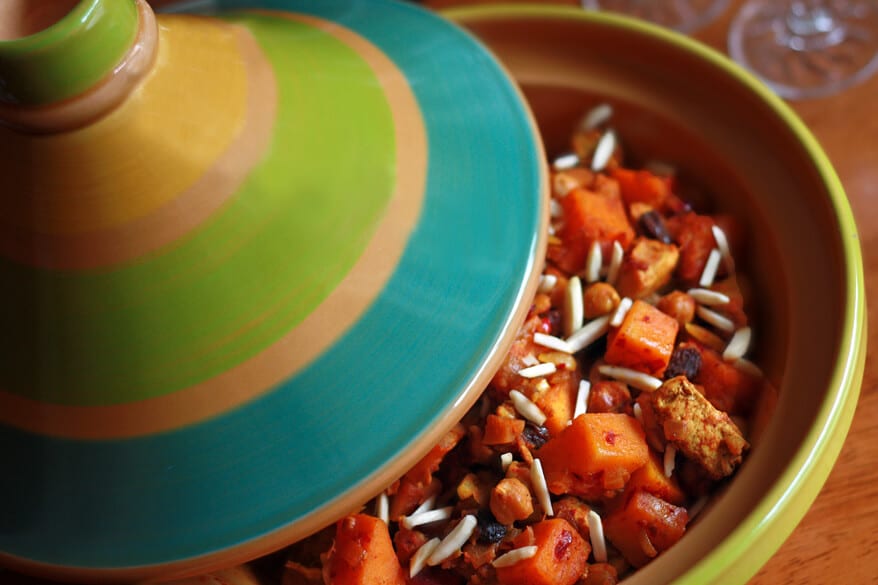
What is a Tagine?
The name tagine refers to both the food as well as the pot in which the food is traditionally cooked. A tagine is a special North African pot formed entirely of a heavy clay, which is often painted or glazed. It consists of a base where the food is placed and a large cone/dome-shaped lid that is designed to promote the return of all condensation to the bottom. The clay construction allows for even heat distribution and low and slow cooking to make the food moist and flavorful. With the cover removed, the base can be taken to the table for serving. For this recipe I’m using a Dutch oven which is likewise ideally suited for slow cooking.

How to Season and Care for a Ceramic Tagine:
If you’re using your new tagine for the first time, it needs to be “cured” prior to its first use to prevent it from cracking. To do this:
- Soak your tagine in water overnight or up to 24 hours, making sure it is submerged under water (you can do this in the sink or bathtub. After it has soaked, wipe it dry and let it air dry for a couple of hours.
- Rub it down everywhere with olive oil, inside and out (both the lid and base), not so it’s dripping but so it’s well-coated.
- Place the tagine in the oven, set the temperature to 300 F / 150 C, and let it “cure” in the oven for 2 hours. Turn off the oven and leave the tagine inside until it is fully cooled. Do not remove it until it has cooled completely.
- Remove the tagine from the oven and give it another light brushing all over with olive oil. Let it sit and soak in the oil for at least another hour or two.
- Your tagine is ready to use.
Tagines should always be washed by hand, dried, and then rubbed with a little olive oil. When washing use warm water, not hot or cold. To avoid it cracking, make sure to avoid any sudden changes in temperature (going from cold to hot or vice versa), such as placing a cold tagine in a hot oven or over a high flame on the stovetop.
To cook with your tagine, you can use it in the oven, place it directly on an electric stovetop, or place it on a metal diffuser on top of a gas stovetop.
Chicken Tagine Ingredients
Let’s talk about about a couple of key Moroccan ingredients in this chicken tagine recipe that add a very distinct flavor to the dish:
- Harissa: Harissa is a fiery Tunisian chile paste that is also commonly used in Moroccan cooking. It’s comprised of dried chiles, olive oil, garlic and spices. I always make my own because it’s super easy to and it tastes far better than anything store-bought. Grab my recipe for homemade Harissa. Alternatively you can use a regular chili paste as a substitute to give you some color and a little kick.
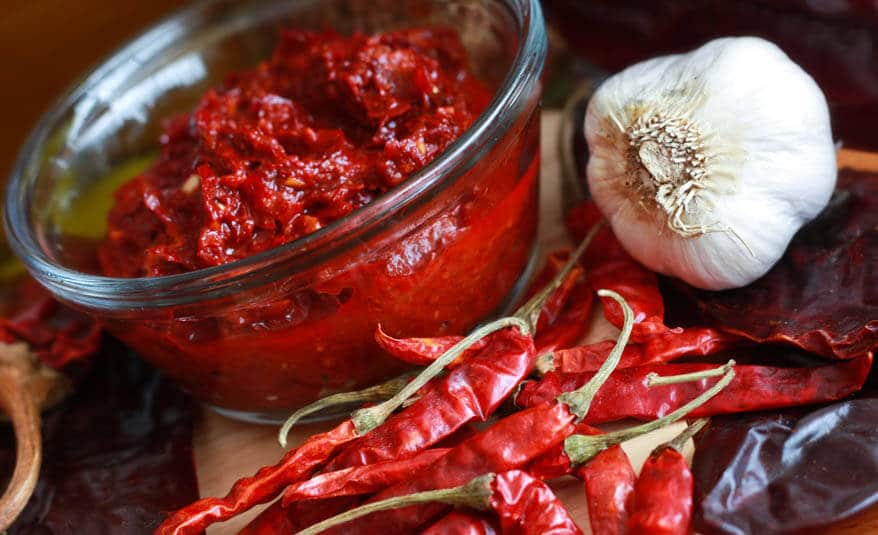
- Preserved Lemons: This is another integral ingredient in this Moroccan chicken tagine and to Moroccan cooking at large. They completely transform every dish in which they’re used. It’s an ultra concentrated and wonderfully mellow lemon flavor without the sourness. And they’re SO easy to make, not to mention incredibly versatile. Again, store-bought cannot begin to compare in flavor to homemade. Get my recipe for homemade Preserved Lemons.

Other key ingredients that capture that authentic Moroccan flavor are:
- Dried Fruits: We’re using dried apricots and raisins.
- Nuts: We’re using slivered almonds. They look elegant and they are sturdy enough to hold their shape (unlike flaked almonds) and provide that nice contrasting crunch.
- Onions, Garlic and Ginger: Highly fragrant and flavorful, they’re a must.
- Spices: turmeric, cumin, coriander and cinnamon add wonderful depth of flavor.
- Honey: this touch of sweetness is very Moroccan and also balances the spiciness of the harissa.
- Chicken, Butternut Squash, Garbanzo Beans: This forms the bulk of the chicken tagine. I love the butteriness of butternut squash but you can use any winter squash of your choice, such as acorn or pumpkin.
This incredible interplay of sweet, savory, citrusy and spicy is integral to Moroccan cuisine and makes this chicken tagine absolutely magical.

Serving Recommendations
This Moroccan chicken tagine is a complete meal in and of itself, but it is traditionally served with couscous. Couscous is very tiny pasta grains and is easy to prepare: simply boil two cups of water, add a vegetable or chicken bouillon cube (or salt) along with 2 tablespoons of butter and stir until dissolved. While the water is still boiling, add two cups of couscous, cover the pan, and turn off the heat. Let it sit for 10 minutes and then fluff with a fork. It’s ready to serve!
Moroccan Tagine + Fluffy Couscous = Heaven. Why did they never teach us that equation in math class?
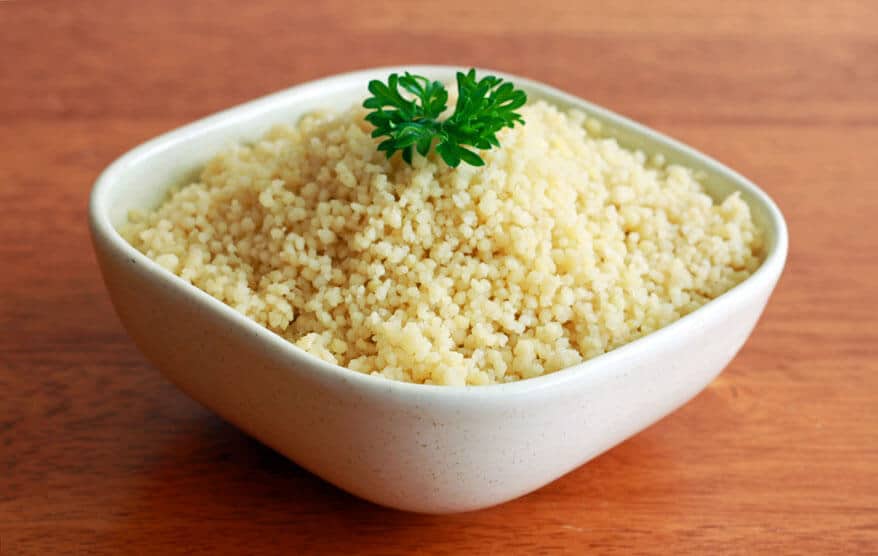
Chicken Tagine Recipe
Let’s get started!
* If using a tagine: Transfer everything to the tagine after adding the butternut squash. Place the tagine with the lid on in a cold oven, set the temperature to 325 F / 160 C, and cook for at least 1 to 1 1/2 hours. At that point check to see if the squash is soft and if not, continue baking until it is. Be sure to follow the instructions in the blog post above to properly season it prior to its first use.
In a Dutch oven or heavy pot, saute the onion until translucent, about 5 minutes. Add the garlic and ginger and saute for another 2 minutes. Add the chicken and the dry spices. Stir to combine and cook for 3-5 minutes until the chicken is no longer pink.
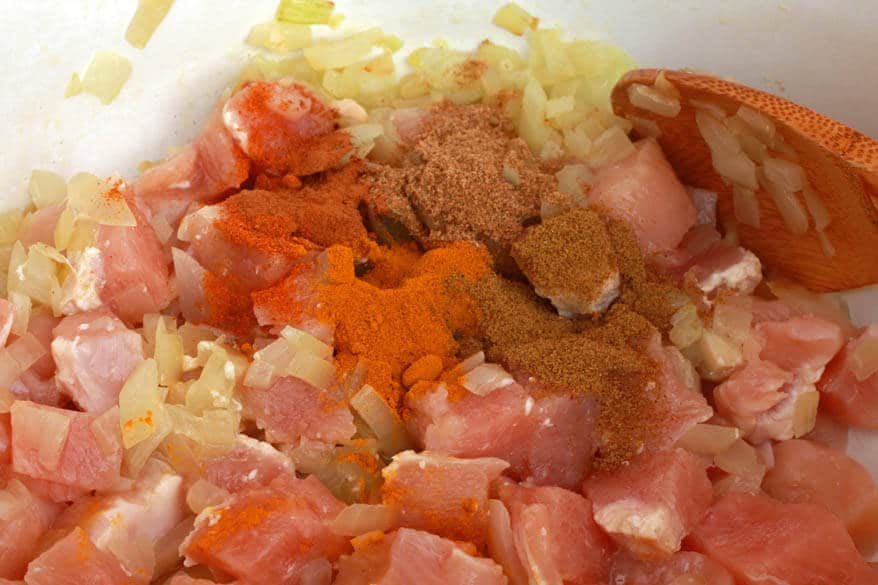
Add the harissa, apricots, raisins, almonds, broth, bouillon cubes, honey, preserved lemon and garbanzo beans. Stir everything to combine. Bring to a simmer, reduce the heat to low, cover, and simmer for 10 minutes.
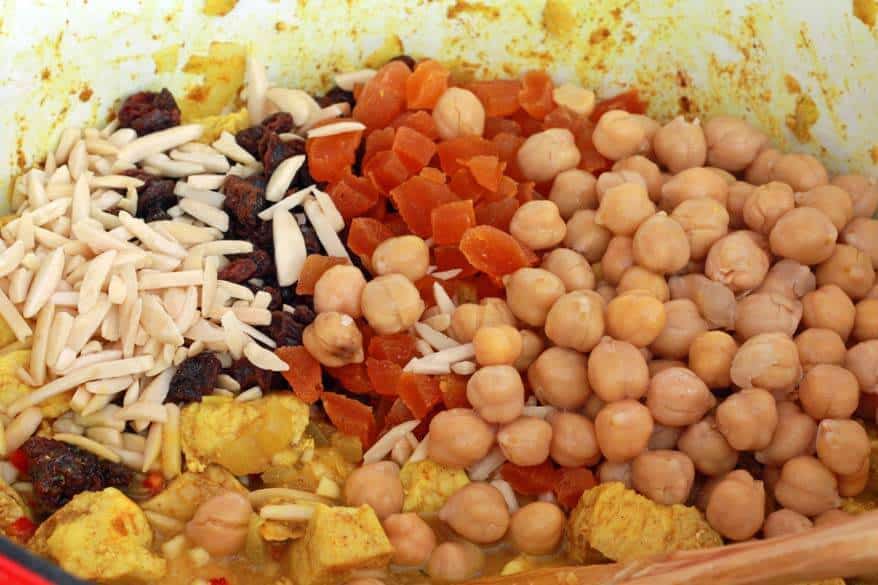
Add the butternut squash, stir to thoroughly combine, return to a simmer, reduce the heat to low again, cover and simmer for another 25 minutes or until the butternut squash is fork-tender. Add salt to taste.
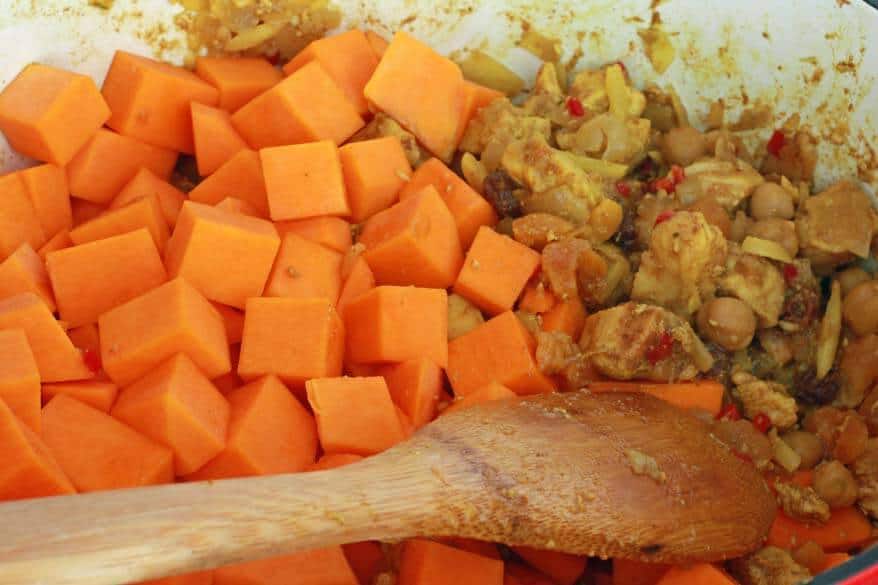
Transfer the chicken tagine to a warmed serving dish and top with extra slivered almonds. Serve with couscous.
Enjoy!
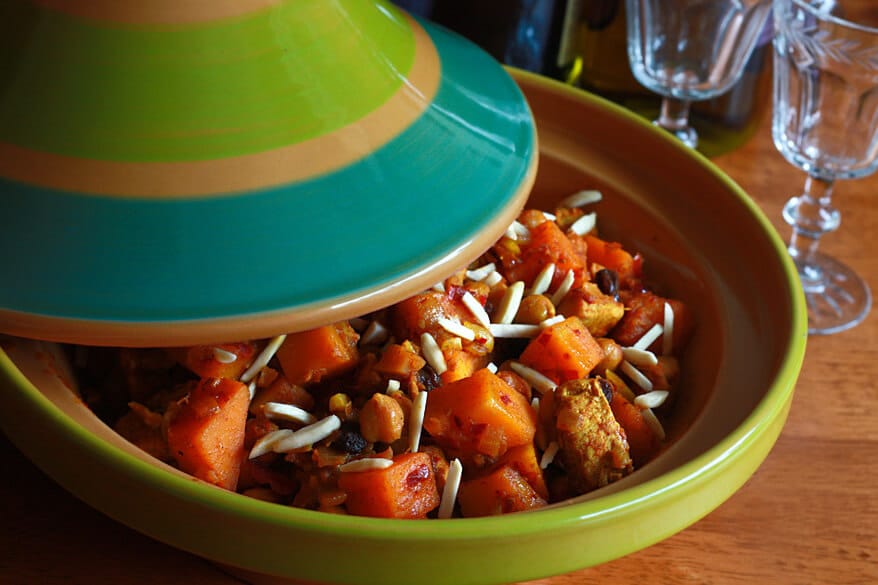
Save This Recipe

Moroccan Chicken Tagine
Ingredients
- 2 tablespoon olive oil
- 1 medium onion , diced
- 1 tablespoon fresh garlic , minced
- 1 tablespoon fresh ginger , grated
- 1 lb chicken breast , diced (vegetarian/vegan: use 3 extra cups squash and an extra can of garbanzo beans)
- 2 teaspoons ground turmeric
- 2 teaspoons ground cumin
- 2 teaspoons ground coriander
- 1/2 teaspoon ground cinnamon
- 1 cup chicken broth (vegetarian/vegan: use vegetable broth)
- 15 ounce can garbanzo beans , drained and rinsed
- 1 tablespoon harissa , or less if you prefer less spicy (can substitute other red chili paste)
- 1 1/2 tablespoons honey (vegan: substitute agave or brown rice syrup)
- 1/3 cup dried apricots , chopped
- 1/3 cup raisins
- 1/3 cup slivered almonds
- 1/2 preserved lemon , click link for recipe (fresh lemons are not a substitute)
- 4 cups butternut squash , or sweet potatoes or pumpkin, peeled, seeded and cut into bite sized pieces
- salt to taste
- extra slivered almonds for garnishing
- For the Couscous:
- 2 cups chicken broth (vegetarian/vegan: use vegetable broth)
- 2 tablespoons butter (vegans: use oil)
- 2 cups couscous
Instructions
- * If using a tagine: Transfer everything to the tagine after adding the butternut squash. Place the tagine with the lid on in a cold oven, set the temperature to 325 F / 160 C, and cook for at least 1 to 1 1/2 hours. At that point check to see if the squash is soft and if not, continue baking until it is. Be sure to follow the instructions in the blog post to properly season it prior to its first use. Note, the cooking time for this recipe applies to the stovetop Dutch oven method.Heat the oil in a large Dutch oven or heavy pot over medium-high heat. Add the onion and saute until translucent, about 5 minutes. Add the garlic and ginger and saute for another 2 minutes. Add the chicken, turmeric, coriander, cumin, and cinnamon, stir to combine, and saute until the chicken is no longer pink.Add the broth, chickpeas, harissa, honey, apricots, raisins, almonds, and preserved lemon. Stir to combine. Bring it to a boil, reduce the heat to low, cover and simmer for 10 minutes.Add the butternut squash, stir to combine, return to a simmer, reduce the heat to low, cover and simmer for another 25 minutes, or until the squash is fork-tender.Garnish with some slivered almonds and serve with the couscous.This will keep in the fridge for up to 3 days.
- To make the Couscous:Bring the water to a boil in a medium saucepan. Add the butter and bouillon cubes and stir until dissolved. While the water is still boiling, add the couscous. Turn off the heat, cover, and let stand for 10 minutes. Fluff with a fork and serve.
Nutrition
Originally published on The Daring Gourmet February 15, 2013



















It looks so amazing and delicious. I cannot wait to try this at home. Great Job.
Thanks, Alona!
In the recipe, it states “add the lemon juice” but it never tells us how to use the preserved lemon. Can you clarify that please?
Hi Chuck, sorry that should read lemon, not juice (referring to the preserved lemon).
This recipe is fantastic. We had just gotten home from Marrakech, and I was yearning to use my new tagine… I went out on a limb and tried this with company the first time out of the gates…It is now in my repertoire of company-worthy dishes — AND kid-friendly cuisine (it pleased our gourmet friends AND my 4 year old, who is perhaps the tougher critic). These flavors meld so exquisitely. My only addition was 1/2 tsp or slightly less of ras-el-hanout (a spice mix we brought back with us). Thank you, Daring Gourmet, for putting such a palate-satisfying dish in my amateur reach!
That’s terrific, Jennifer, I’m so thrilled it’s been such a hit and that your courage in trying a dish for the first time on guests paid off! I really appreciate the feedback, thank you! Best, Kimberly
This sounds amazing and I can’t wait to try it including making the preserved lemon and Harissa. I’m going for the experience . You mention using a Tagine is different. I’m in the process of seasoning my Tagine now. It will be ready in a few days but that will give me time for the lemons. So how would I do this recipe using a Tagine? Thanks.
Hi Lisa! Yes, proper seasoning is important. After that you’ll place the ingredients in it and bake it in the oven – the maximum oven temperature should be 325 F and it will need to cook 3-3 1/2 hours. Avoid opening it too frequently, just check once or twice towards the end to make sure the veggies are tender.
Hi Kimberly,
Thanks for the great site, can’t wait to try some of your recipes.
Any tips on purchasing a Tagine? Friends gave us a very nice small one, but we would like to purchase a large tagine as we like lots of leftovers and/or room to make plenty for guests. I see the one you have pictured has a deeper base than the ones I’ve seen online.
Pat
Hi Pat, thanks so much! :) The options are very limited here in the U.S. unfortunately. I’m in the Seattle area and there are some specialty shops here that carry a few. But there are also a few on Amazon, for example Emile Henry (expensive), Le Creuset (even more expensive), and Le Souk, etc.
It was a nice little dish, but the sweetness of honey/raisins/apricots are too much sweetness so the preserved lemons dont stand out.
Hi Simon, taste is always subjective but it’s all about achieving harmony between the flavors without any one overly dominating the rest.
AWESOME TASTE! For step 1, I used bone-in chicken legs . . . and added a little more water so that the chicken would cook slowly and thoroughly. It took a little longer but sooooo worth it!. I also bought the harissa cause I don’t use it often and didn’t feel like making my own (perhaps at another time). .. but it still turned out great and yes, for anyone wanting to skip the preserved lemons – DON’T! It adds a certain distinct flavour that you can’t get from regular lemon juice. For the 3 chicken cubes, I only had 1. but I had knorr vegetable stock so I used the 1 cube, the concentrated stock and it still came out tasty.
Thank you Kimberly… this recipe is gonna be a popular one in the house. HAPPY NEW YEAR!
Jennifer, I’m soooo happy to hear you made and enjoyed this! It’s one of my favorite dishes to make for guests, they’re always elated. I couldn’t agree more about the preserved lemons, there simply is no adequate substitute for them and their flavor is simply incredible. And I don’t always make my own harissa either, sometimes I’m just too lazy ;) Thanks so much for your feedback and a Happy New Year to you and your family!
Few questions–
–How is this recipe if made the day ahead and reheated?
–I like the added flavor of thigh meat. Could use boneless/skinless or bone in and skin on. I like your “stew” form –makes it easier to scoop with bread, but bones etc add to the flavor.
which would you suggest?
—I was surprised that you say to put the Tagine in the oven. Thought they were mostly used on the stovetop.
Hi Judy! This dish is ideally served immediately because the texture of the squash may become a bit mushy the next day. It would likely taste even better the next day though after the flavors have had more time to meld. Yes, thigh meat always adds more flavor and you can certainly use bone-in chicken for this. Tagines: Use can use them either way – oven or stovetop. They’re made of clay which is perfect for using in the oven to get a nice slow-cook. Traditionally they’re cooked on hot coals which envelops the tagine, so in the absence of coals the oven is a good alternative. Happy cooking!